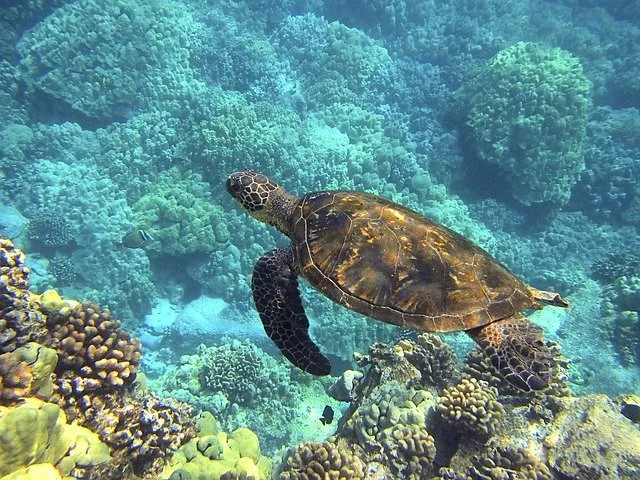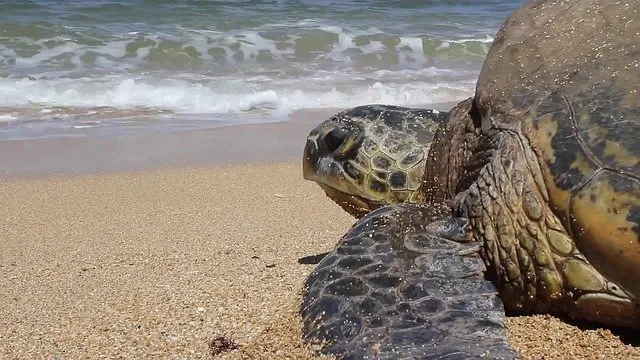As an Amazon Associate I earn from qualifying purchases.
Welcome to the depths of the Pacific, where the mesmerizing world of Hawaiian sea turtles unfolds beneath the sunlit waves. In this exploration, we dive into the intricate details of the honu’s culinary choices, unraveling the mysteries surrounding the age-old question: “What do Hawaiian sea turtles eat?” Beyond the sun-drenched shores and swaying palms, these gentle marine giants graze and glide through a diverse menu of oceanic delights. Join us on a captivating journey as we uncover the nutritional secrets that sustain these majestic creatures in the vibrant underwater tapestry of the Hawaiian Islands.
What Do Hawaiian Sea Turtles Eat?
Hawaiian sea turtles, also known as honu, are majestic marine creatures that glide gracefully through the crystal-clear waters of the Pacific. Have you ever wondered what fuels these incredible beings beneath the waves? Join us on a gastronomic journey as we explore the delectable menu of Hawaiian sea turtles and unravel the secrets of their dietary choices.
1. Seagrasses: A Verdant Feast
Seagrasses are at the heart of the Hawaiian sea turtle’s diet. These marine plants provide a nutrient-rich foundation, offering a variety of essential vitamins and minerals. The honu delicately grazes on seagrasses, contributing to the delicate balance of the underwater ecosystem. Seagrasses sustain the turtles and serve as an integral part of their habitat.
2. Algae: The Ocean’s Superfood
Algae, the unsung hero of the ocean, is a rich source of nutrients and provides essential sustenance for the gentle giants of the Hawaiian sea turtle. From green to brown to red varieties, algae offers an array of flavors and nutrients, ensuring that the honu maintains optimal health while navigating the vast ocean expanse.
3. Jellyfish: A Slippery Affair
In a surprising twist, Hawaiian sea turtles are known to indulge in the occasional jellyfish snack. Despite the challenges posed by their gelatinous prey, the honu skillfully navigates the potentially dangerous encounter. Jellyfish provide a protein-rich alternative to the vegetarian staples in the sea turtle diet, adding a unique dimension to their culinary choices.
4. Crustaceans: A Protein Boost
When honu crave a protein boost, they turn to crustaceans in Hawaiian waters. Crabs and other small crustaceans offer a savory addition to sea turtle diets, ensuring a well-rounded nutritional profile. The turtles’ powerful jaws and beaks allow them to expertly capture and consume these marine morsels, showcasing their adaptability in selecting diverse food sources.
5. Sponges: A Culinary Curiosity
For the more adventurous sea turtles, sponges appear on the menu. While not a staple, some honu has been observed consuming certain species of sponge. This intriguing behavior adds a layer of complexity to our understanding of the Hawaiian sea turtle’s dietary preferences, highlighting the need for ongoing research to unravel the mysteries of their culinary choices.
What Hunts Hawaiian Sea Turtles?
In the azure waters of the Pacific, Hawaiian sea turtles, or honu, navigate a delicate dance between survival and predation. Despite their formidable size and sturdy shells, these gentle giants are not immune to the challenges posed by natural predators. Join us as we explore the intricate web of the underwater food chain and discover the predators that lurk in the shadows, ready to seize an opportunity for a meal.
1. Sharks: Silent Guardians of the Deep
Sharks are among the most formidable predators of Hawaiian sea turtles. In particular, Tiger and great white sharks are known to patrol the coastal waters of Hawaii, seeking prey. The honu’s slow swimming speed and relatively unprotected flippers make them vulnerable to opportunistic attacks. Despite their thick shells, adult sea turtles are not invincible, and encountering sharks can result in injuries or even fatalities.
2. Saltwater Crocodiles: Rare But Lurking
While not as common as sharks, saltwater crocodiles are known to inhabit some of the coastal areas around the Hawaiian Islands. These powerful reptiles are ambush predators, patiently waiting for unsuspecting prey to venture too close to the water’s edge. Though encounters between Hawaiian sea turtles and saltwater crocodiles are relatively rare, these ancient predators add an extra layer of complexity to the honu’s survival story.
3. Large Fish Species: The Ambush Masters
Barracudas and groupers are examples of large fish species that threaten Hawaiian sea turtles. Employing stealth and lightning-fast strikes, these predators often await an opportune moment to ambush their prey. While adult sea turtles may have a better chance of fending off such attacks, juvenile turtles are more vulnerable to the swift maneuvers of these underwater predators.
4. Humans: A Manmade Threat
In addition to natural predators, human activities significantly threaten Hawaiian sea turtles. Historically, honu faced exploitation for their meat, shells, and eggs. Today, accidental entanglement in fishing gear, collisions with boats, and habitat destruction further jeopardize the survival of these majestic creatures. Conservation efforts and protective measures are crucial to mitigating the impact of human activities on Hawaiian sea turtle populations.
How Hawaiian Sea Turtles Impact Our Ecosystem?
The Hawaiian sea turtle, or honu, plays a pivotal role in shaping the delicate balance of the marine ecosystem. These ancient creatures, revered in Hawaiian culture, contribute in myriad ways that extend far beyond their captivating presence. Join us on a journey to explore how Hawaiian sea turtles impact our ecosystem and why their conservation is crucial for the health of the oceans.
1. Seagrass Grazers: Guardians of Coastal Ecosystems
Hawaiian sea turtles are avid consumers of seagrasses, and their grazing habits have profound implications for coastal ecosystems. By maintaining seagrass beds through selective feeding, honu promotes the growth and health of these vital habitats. Healthy seagrass ecosystems, in turn, support a diverse array of marine life, including fish and invertebrates, creating a flourishing environment for the entire coastal ecosystem.
2. Algae Control: Balancing Biodiversity
In addition to seagrasses, Hawaiian sea turtles play a crucial role in controlling algae populations. Their selective consumption helps prevent overgrowth of algae, which, if left unchecked, could smother coral reefs and disrupt the delicate balance of the underwater environment. The honu, acting as natural grazers, contribute to maintaining biodiversity and preserving the health of coral reef ecosystems.
3. Beach-nesting Impact: Influencing Dune Formation
When female sea turtles come ashore to lay their eggs, they inadvertently impact the sandy beaches. As they dig nests and later cover them, they contribute to the formation and maintenance of dunes. This process stabilizes coastal areas, providing a natural defense against erosion and storm surges. The presence of nesting sea turtles thus contributes to the resilience of coastal ecosystems.
4. Nutrient Cycling: From Ocean to Land
As sea turtles feed on various marine organisms, they become part of a nutrient-cycling process that extends from the ocean to the land. When turtles return to nesting beaches to lay eggs, the nutrients from their bodies enrich the soil. This nutrient transfer can positively influence the surrounding vegetation, creating a connection between marine and terrestrial ecosystems that underscores the interdependence of life in coastal areas.
5. Tourism and Cultural Significance: A Unique Ecotourism Opportunity
The charismatic appeal of Hawaiian sea turtles has made them a flagship species for marine conservation and ecotourism. Responsible tourism centered around these creatures provides economic incentives for local communities and fosters a deeper understanding of the importance of preserving marine ecosystems. The cultural significance of honu in Hawaiian mythology further emphasizes the need for sustainable practices to ensure their continued presence in the region.
Final Words
In conclusion, our exploration of Hawaiian sea turtles’ dietary habits and ecological impact unveils a fascinating narrative of harmony beneath the waves. From seagrass-grazing maestros to inadvertent architects of coastal resilience, these honus play a crucial role in shaping the health of marine ecosystems. As we marvel at the intricate connections between their culinary choices and the broader underwater world, it becomes clear that understanding “What do Hawaiian sea turtles eat?” is not just a curiosity but a gateway to appreciating their indispensable role in maintaining the delicate balance of our oceans. The conservation of these ancient creatures is not merely an environmental duty but a pledge to safeguard the intricate web of life that thrives beneath the cerulean surface of the Pacific.
You can also read:
1.What Do Chiweenies Eat? Chiweenie Culinary Chronicles
2.What Do Bengal Cats Eat? Unlocking the Culinary Code
3.What Do Pacific White-Sided Dolphins Eat? Exploring the Palate
4.What Do Thoroughbreds Eat? The Art of Feeding Champions
Amazon and the Amazon logo are trademarks of Amazon.com, Inc, or its affiliates.



